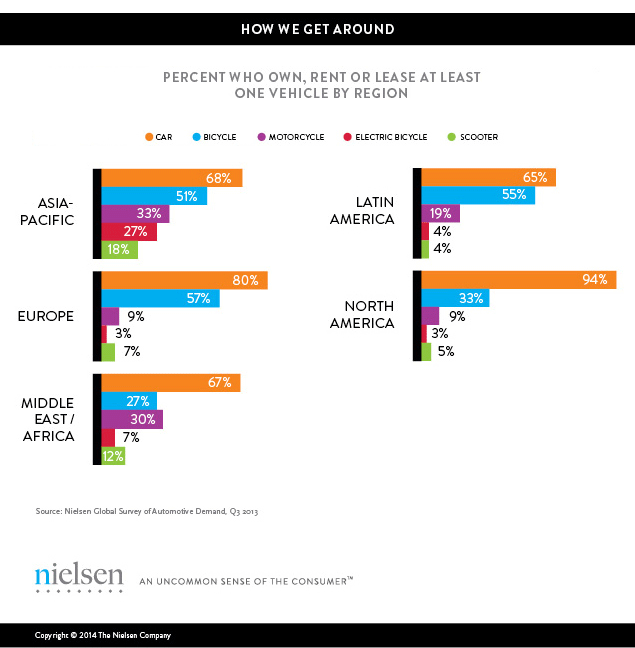While demand for cars continues to grow around the world, many rely on less advanced forms of transportation for their daily travels. So how do we get around town around the world when we aren’t using a car, or don’t own one? We often hop on some type of two-wheeled vehicle.
Aside from cars, the most commonly owned vehicles around the world are more traditional, with half of global respondents (49%) in Nielsen’s Global Survey of Automotive Demand owning at least one bicycle and 22 percent owning at least one motorcycle. And those looking for a middle ground between manpower and horsepower opt for an electric bicycle (15%) or scooter (11%) as their vehicle of choice.
Bicycles are a popular method of transportation globally, given their relatively low cost, the little maintenance they require, ease of use and environmentally friendly benefits. More than half of respondents in Europe (57%), Latin America (55%) and Asia-Pacific (51%) own at least one bicycle. Bicycle ownership is highest in Denmark (89%), the Czech Republic (82%), Finland (82%) and the Netherlands (81%), with some respondents indicating that they own as many as nine bicycles per household. Meanwhile, ownership is lowest in North America (33%) and the Middle East/Africa (27%).
In countries where road infrastructure and rugged terrain require more horsepower and where crowded city streets require maneuverability, motorcycles are the two-wheeled vehicle of choice. Ownership in Asia-Pacific (33%), Middle East/Africa (30%) and Latin America (19%), double and sometimes more than double the ownership levels in North America (9%) and Europe (9%). Motorcycle ownership at a country level is highest in Indonesia (91%), Thailand (72%), India (71%) and Pakistan (64%).
Those looking for the convenience of motorized transportation, but not requiring the speed of motorcycles, opt for scooters. Ownership is highest in Asia-Pacific (18%) and the Middle East/Africa (12%) and lowest in Latin America (4%), North America (5%) and Europe (7%). In countries like Vietnam, Taiwan and India, navigating densely crowded streets with these vehicles can be most efficient.
The popularity of electric bicycles has grown in recent years. They offer an inexpensive option for convenient travel on gridlocked streets, and ownership is greatest in Asia-Pacific, where 27 percent of respondents own at least one electric bicycle. Electric bicycles are most popular in China, where ownership is 45 percent, followed by Vietnam (27%). The trend has not yet gained the same traction in the Middle East/Africa (7%), Latin America (4%), North America (3%) and Europe (3%), where ownership is still nascent.

Other findings include:
- Insight into who potential car buyers are and where they live.
- A detailed look at how to effectively reach customers with mixed media advertising.
- Quick-reference country scorecards for: India, Brazil, Russia, Mexico, Indonesia, Turkey, the U.S. and Germany.
For more detail and insight, download Nielsen’s global survey of automotive purchase intent.
About the Nielsen Global Survey
The findings in this survey are based on respondents with online access across 60 countries. While an online survey methodology allows for tremendous scale and global reach, it provides a perspective only on the habits of existing Internet users, not total populations. In developing markets where online penetration has not reached majority potential, audiences may be younger and more affluent than the general population of that country. Additionally, survey responses are based on claimed behavior, rather than actual metered data.




